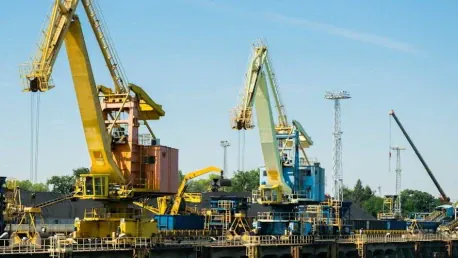In a significant move to address the growing commercial and non-commercial traffic demands at the U.S.-Mexico border, the U.S. General Services Administration (GSA), in partnership with the city of Douglas, Arizona, recently acquired 80 acres of land to construct a new commercial port of entry. This initiative was marked by a land transfer ceremony on December 4, attended by 130 people, including city Mayor Donald Huish and GSA officials. The project aims to alleviate pressures on the existing Raul Hector Castro Land Port of Entry, which has been in operation since 1933 and last saw an expansion in 1997. The new facility is expected to open in 2028 and will complement the existing crossing by dedicating itself to commercial activities while the Castro port handles non-commercial endeavors.
The development of this new port of entry is part of broader efforts to enhance trade efficiency, bolster border security, and stimulate economic growth in the region. The present Raul Hector Castro port, with its aging infrastructure, has long struggled to meet the growing traffic demands, leading to significant delays and inefficiencies. The new port aims to process commodities with much greater efficiency and safety, supporting economic development by accommodating increased traffic volumes. Attendees at the ceremony, including Martin Gomez, the CBP area port director, highlighted the port’s potential in promoting trade and regional connectivity.
Project Goals and Strategic Significance
The rationale behind building the new commercial port revolves around addressing the limitations of the current infrastructure. Since its inception nearly a century ago, and with its last expansion over two decades ago, the Raul Hector Castro Land Port of Entry clearly falls short in handling the present-day traffic needs. With the anticipated growth in trade between Arizona and Mexico, this move is seen as a critical step in upgrading inspection capabilities and overall border infrastructure to support Customs and Border Protection’s (CBP) objectives. These advancements will not only streamline the process of commodity inspection but also significantly enhance border security measures.
From an economic perspective, the new port is expected to be a game-changer. It is anticipated to significantly reduce waiting times and boost the overall throughput of goods, thereby facilitating smoother trade flows and stronger economic ties between the two nations. Both U.S. Rep. Juan Ciscomani and U.S. Sen. Mark Kelly underscored the significance of this project in boosting trade, creating new jobs, and enhancing border security through modern technology and expanded capacity. The project’s budget, set at $319 million, has already seen substantial investment with a $274.7 million design-build contract awarded to an Arizona firm in October.
Anticipated Enhancements and Community Impact
The improvements slated for the new commercial port include a substantial increase in inspection lanes and docks. Currently, the Castro port is equipped with only one commercial vehicle inspection lane and 12 inspection docks, which has led to bottlenecks and inefficiencies over the years. The new facility will feature four commercial vehicle inspection lanes and a massive increase to 36 inspection docks. Additionally, it will have the capability to process oversized equipment, which is not currently feasible at the Castro port. These enhancements are expected to streamline operations and minimize delays, making cross-border trade significantly more efficient.
From a community perspective, the benefits of this project extend beyond just facilitating trade and commerce. Mayor Huish has emphasized the long-term positive impacts on the local community, which include enhanced job opportunities, improved statewide connectivity, and heightened security measures. This new port is poised to revitalize the regional economy by attracting new businesses and investments, thereby creating a ripple effect of economic growth throughout Douglas and beyond. The collaborative efforts between federal and local entities underscore a unified commitment to modernizing infrastructure and ensuring it meets the demands of contemporary commerce and security needs.
Conclusion and Future Outlook
In a major step to meet the rising commercial and non-commercial traffic at the U.S.-Mexico border, the U.S. General Services Administration (GSA), alongside the city of Douglas, Arizona, has procured 80 acres for a new commercial port of entry. Marked by a land transfer ceremony on December 4, attended by 130 people, including Mayor Donald Huish and GSA officials, this project is aimed at reducing the strain on the existing Raul Hector Castro Land Port of Entry. Operating since 1933 and last expanded in 1997, the current port has been struggling with increased traffic demands. The new facility, set to open in 2028, will focus on commercial activities, while the Castro port will handle non-commercial traffic.
This initiative is part of a broader strategy to improve trade efficiency, bolster border security, and foster economic growth in the area. The aging infrastructure of the Raul Hector Castro port has caused delays and inefficiencies, making the new port crucial for handling more traffic safely and efficiently. Attendees, including Martin Gomez, the CBP area port director, emphasized the new port’s role in enhancing trade and regional connectivity.









